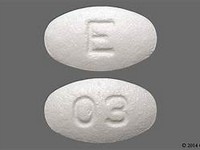Bendroflumethiazide

Bendroflumethiazide
CLINICAL USE
Thiazide diuretic:
Hypertension Oedema DOSE IN NORMAL RENAL FUNCTION
Oedema: 5–10 mg in the morning or alternate daysMaintenance: 5–10 mg, 1–3 times weeklyHypertension: 2. 5 mg daily PHARMACOKINETICS
Molecular weight :421.4 %Protein binding :94 %Excreted unchanged in urine : 30 Volume of distribution (L/kg) :1.2–1.5half-life – normal/ESRD (hrs) :3–9/– DOSE IN RENAL IMPAIRMENT
GFR (mL/MIN)
20 to 50 : Dose as in normal renal function 10 to 20 : Dose as in normal renal function <10 : Unlikely to work DOSE IN PATIENTS UNDERGOING RENAL REPLACEMENT THERAPIES
CAPD :Unlikely to be dialysed. Unlikely to work. HD :Not dialysed. Unlikely to workHDF/high flux :Unknown dialysability. Unlikely to workCAV/VVHD :Probably not dialysed. Unlikely to work IMPORTANT DRUG INTERACTIONS
Potentially hazardous interactions with other drugsAnalgesics: increased risk of nephrotoxicity with NSAIDs; antagonism of diuretic effectAnti-arrhythmics: hypokalaemia leads to increased cardiac toxicity; effects of lidocaine and mexiletine antagonisedAntibacterials: avoid administration with lymecyclineAntidepressants: increased risk of hypokalaemia with reboxetine; enhanced hypotensive effect with MAOIs; increased risk of postural hypotension with tricyclicsAnti-epileptics: increased risk of hyponatraemia with carbamazepineAntifungals: increased risk of hypokalaemia with amphotericinAntihypertensives: enhanced hypotensive effect; increased risk of first dose hypotension with post-synaptic alpha-blockers like prazosin; hypokalaemia increases risk of ventricular arrhythmias with sotalolAntipsychotics: hypokalaemia increases risk of ventricular arrhythmias with amisulpride or sertindole; enhanced hypotensive effect with phenothiazines; hypokalaemia increases risk of ventricular arrhythmias with pimozide – avoid concomitant useAtomoxetine: hypokalaemia increases risk of ventricular arrhythmiasCardiac glycosides: increased toxicity if hypokalaemia occursCiclosporin: increased risk of nephrotoxicity and hypomagnesaemiaLithium excretion reduced, increased toxicity ADMINISTRATION
Reconstition
– Route
Oral Rate of Administration
–Comments
– OTHER INFORMATION
Monitor for hypokalaemia Thiazide diuretics are unlikely to be of use once GFR<30 mL/min
See how to identify renal failure stages according to GFR calculation
See how to diagnose irreversible renal disease
Home









